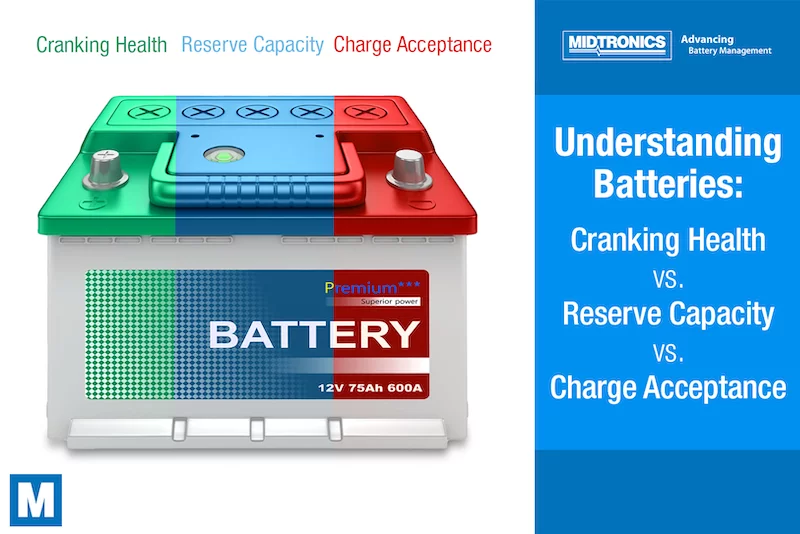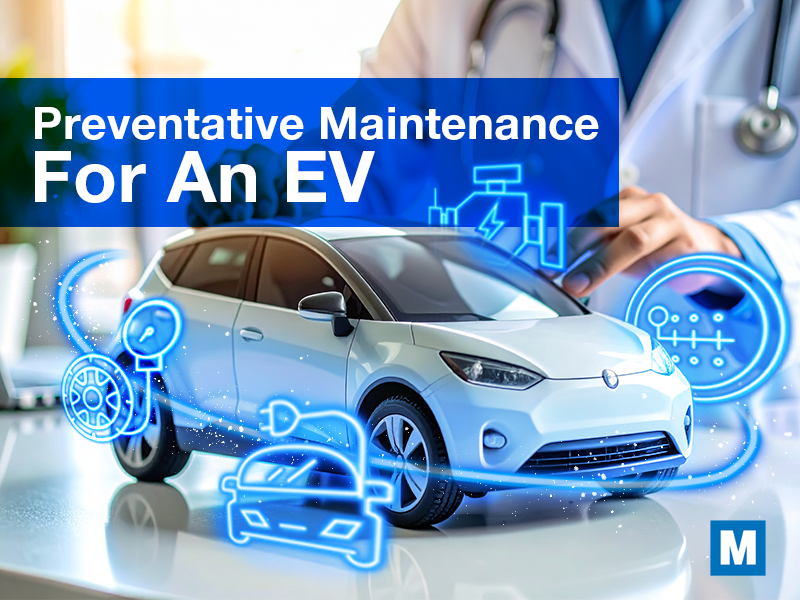Car batteries are tested for various reasons. It could be at the customer’s request due to an issue they’re experiencing or as a complimentary service to proactively identify bad batteries before they leave the driver stranded. Whatever the reason, in-vehicle and out-of-vehicle battery tests similarly return the results every time, commonly known as testing decisions.
Decisions displayed from a battery test are often quite clear, stating whether the battery is good, needs to be recharged and re-tested, or requires replacement. However, the reasons behind the test decisions aren’t always self-evident. Here’s what you need to know about testing criteria, battery test decisions, and what the results might be indicating for each criterion.
Cranking Health
In a Midtronics battery tester, one component for an in-vehicle test is a cranking health check. This does not mean the engine is actually turned over during the test, but that the cold cranking amperage is analyzed against the battery’s rated standard. Aside from the voltage, it’s arguably the most common area that most individuals testing batteries look at to gauge a battery’s health, at a glance. A charged battery with strong cranking health can perform the function of starting your car.
Reserve Capacity
Often looked past or misunderstood, a battery’s reserve capacity is quite important to reliability. Batteries can have strong cranking health, but poor reserve capacity health. Reserve capacity refers to how many minutes the battery can deliver 25 amps at around 80F before it drops to 10.5 volts.
Poor reserve capacity can leave a driver without enough energy to restart their engine unexpectedly. For instance, listening to the radio in the mall parking lot with the engine off could deplete the reserve capacity in a weak battery, as can leaving the lights on for a short while. It can even lead to start-stop functions to not work properly. It’s vital to diagnose the reserve capacity. Learn more about reserve capacity in our blog “Cars Need more from Batteries than Starting” blog (insert link)
Charge Acceptance
Determining state of health in a battery is even more important with increased electrical demands and tech like Auto Start-Stop. A comprehensive battery test should include charge acceptance diagnostics that determines whether a battery is capable of absorbing current peaks across a range of state of charge states.
Poor charge acceptance can lead to many of the same problematic experiences as poor reserve capacity. The battery will overtime not return to the state of charge it is designed to. This can lead to battery degradation, no-start scenarios, and start-stop functions not performing properly.
What Battery Test Decisions Mean
When a battery test is performed, it generally returns a decision with one of four common messages: Good Battery, Good – Recharge, Charge and Retest, and Replace Battery. The criteria above factor into the test results for testers equipped as such, indicating its state of health.
Good Battery
In a battery test that returns a decision of Good Battery, it means that all of the criteria have been met and the battery is in good condition. Cranking amps, as determined either by the VIN scan or a manual CCA entry before the test, meet or exceed the standard, indicating good Cranking Health. The reserve capacity has enough power to supply the car’s electronics with the engine off, and the battery is capable of accepting a charge well after a serious current draw.
Good Battery – Recharge
When the decision is Good Battery – Recharge, it indicates that the battery has passed the same criteria. It has sufficient cranking amperage and reserve capacity, and Charge Acceptance isn’t an issue. However, the test has found that the voltage is below the normal range, which can point toward either a charging system issue or excessive draw from the starting system.
Charge and Retest
If the decision is to Charge and Retest, it can mean several things. It might be an out-of-vehicle battery test and the charge has waned over weeks or months, or it could be a situation where the ignition has been on for an extended time before the battery test was initiated. However, it can also point to a problem with the charging system where the battery isn’t being replenished fully when the engine is running. In this decision, the reserve capacity is good but it isn’t possible to fully know the condition of a battery before charging fully and performing another test cycle.
Replace Battery
If the test decision is Replace Battery, a number of things could be going on. It’s possible that the Cranking Health is fine but the reserve capacity is insufficient, meaning the battery might not hold a charge well with the ignition off. Or, the reserve capacity might be fine but the cold cranking amps are below the battery’s rating. Also, it could be a condition where both the reserve capacity AND Cranking Health are poor. It’s unlikely that the battery will accept a charge properly if Replace Battery is the result.
Test Every Battery, Every Time
Vehicles today contain upwards of 50 control modules. Between increased technology and the prevalence of Auto Start-Stop features, the battery is heavily relied upon all the time. In extreme temperatures, harsh terrain, and high accessory use conditions, it often doesn’t take much for a battery to go from completely healthy to a less-than-ideal State of Health.
To ensure unexpected breakdowns are few and far between and to give drivers peace of mind, test every battery during every service interval. In only a few minutes, a test decision can reveal whether a battery will continue to service the vehicle reliably or if closer attention needs to be paid. And if your battery testers aren’t equipped to check Charge Acceptance, it might be a good time for an upgrade.




